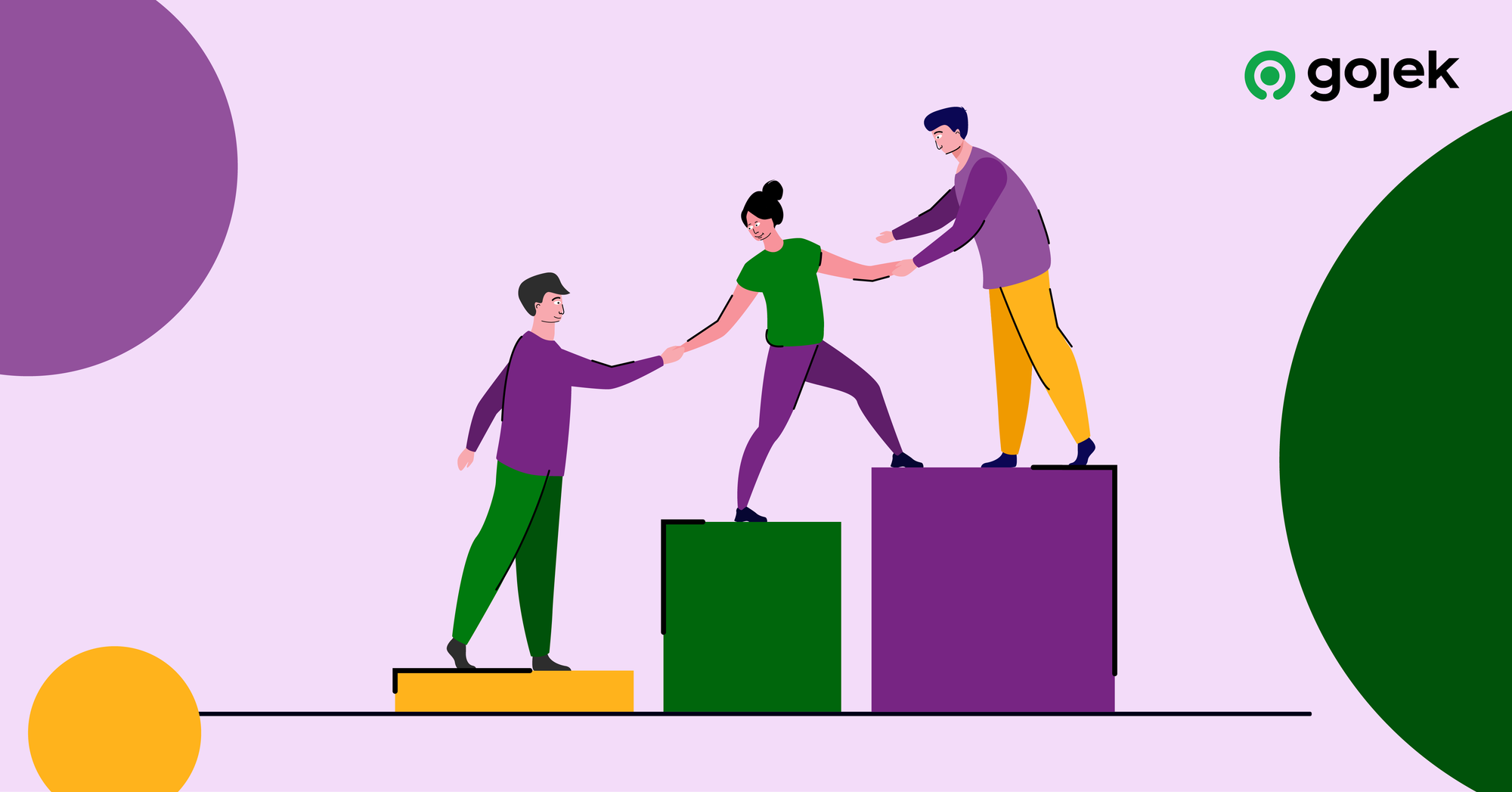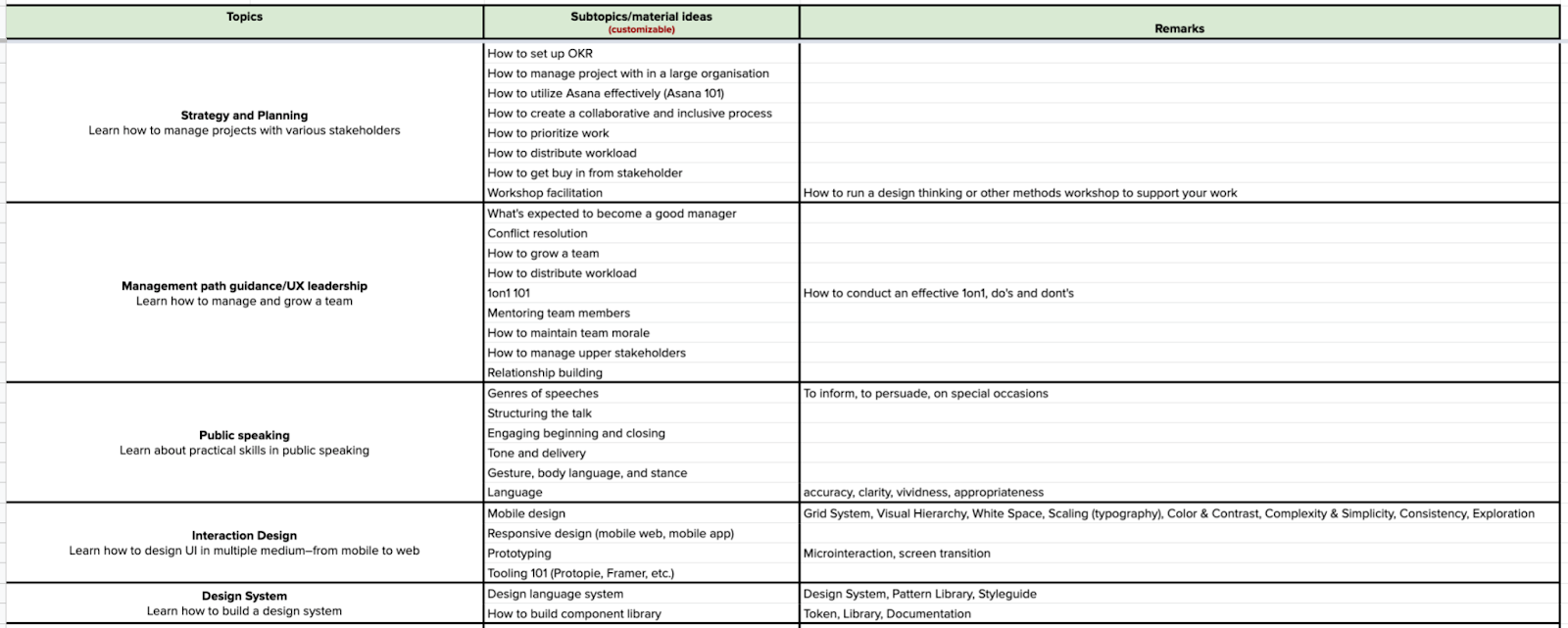Shaping The Culture Of Learning In Gojek Design
How we promote both personal and professional growth through the Gojek Design mentorship program.

By Claudia Salim
Continued professional and personal growth should be a constant process throughout one’s career. The nature of our job as designers urges us to always keep up with the constant change in technology and evolving human behaviour. Hence, it’s important for us to constantly learn.
Fortunately, our designers are always on the lookout for more opportunities to learn, grow, and get better at mastering the craft of design, which indicates the kind of growth mindset we aim to promote. Beside that, with more than 150 designers in the team, we understand it is difficult for one to keep up with everybody. This also leads to a problem where some of our designers feel isolated and don’t feel like they are part of a vibrant community where they can grow as designers.
How can we facilitate the infinite learning opportunities for our designers by optimizing the resources within our company and simultaneously promote social interactions across teams?
Establishing a mentorship program in the Design team
Having acknowledged the problems, we formulated our goals while establishing the program:
- To shape the culture of cross-functional learning which primarily benefits the participants to gain knowledge and skills from the experts in Gojek to progress in their careers
- To build relationships across the Design team and Gojek wider organization
- And to facilitate the designers develop mentoring skills.
Now, how do we define what success would look like? Our main goal is all about learning, so we need to make sure that the participants are able to achieve it optimally. Hence, we pay attention to the ground metrics that can realistically define the success: Program’s effectiveness and usefulness, participant engagement, and design & non-design mentor involvement.
Setting up the baseline
In early 2020, we conducted our very first mentorship program which ran for six months. We adopted the one-on-one mentoring system that matches each mentee with one mentor in order to optimize the learning process. In the end of the first program cycle, we ran a retrospective survey to gather feedback from the participants, which gave us quantitative and qualitative data. All in all, the majority of the participants found the program useful for their career and they were able to grasp the benefits. However, we’ve also got an insight about how it went and what the mentors and the mentees experienced throughout the program–which will be discussed in the next section. This then was used as our problem data in the next program cycle.
Care for what they need
The way we conduct our program depends heavily on the feedback of our participants. Beside the survey, we also talked to the participants in a casual setting about what they struggled with in the program, and what they wish to continue for future reference. Our design leaders also contributed their perspectives to give recommendations on what our designers need to excel in their careers.
We found that it’s important for mentors to understand deeply about their mentees’ learning goals and expectations, and have structured mentoring guidance–given that there are also first time mentors–as well as program maintenance to keep it going. On the other hand, from mentees’ point of view, having a proper curriculum and learning method is what is on top of their mind. Hence, we came up with several recommendations to make the program run better than before.
- Mentors from around the company
We aim to serve fully what our designers need when it comes to learning. Hence, we gathered mentors from around Gojek organization to participate in the program. We’ve got mentors from Product Management, Research, Business Strategy, Program Management, and even Sustainability to share their knowledge to our designers. The range of seniority also varies from interns to very seasoned design and business leaders.
- Design Mentorship Playbook
Creating a comprehensive playbook to guide both mentors and mentees is helpful to get everybody on the same page towards the ground rules. We include the program’s complete process, tips and tricks in conducting the mentoring sessions, do’s and don’ts, to the specific questions to ask during the mentoring sessions.
- Learning Plan
We found that having a learning goal and specific expectations is super important for mentees, and they need to align it with their mentors’ as well. To achieve that, we created a learning plan consisting of components like timeline, action items, learning references, to help them arrange their mentoring sessions neatly. Having this learning plan would also help them understand each other better as the time goes by and create a good dynamic in their relationship.

- Detailed mentorship topics
To inspire both mentors and mentees in structuring a personalized curriculum in their mentoring sessions, we created a detailed topic list as seen below. This list has been developed in a close collaboration with the participants as well as leaders, and is constantly evolving each cycle. We want to make sure that the list is as inclusive as possible, hence we tried our best to accommodate everyone’s other requests, including off-topic mentorships.

- Sharing session for mentors
As we have first time mentors joining the program, we want to provide learning for them too so they can conduct an effective mentoring through knowledge sharing. Our goal is for them to have a space to exchange best practices, strategies, and methods in mentoring. So, we created sharing sessions and channels where all mentors meet and share their wisdom to each other.
- Program check-ins
To optimize the program in running consistently and effectively, we conduct a monthly check-in to each pair of mentor and mentee. In every checkpoint, we make sure that they are on track with their learning focus and facilitate help whenever they need.
Still a long way to go
“It was very insightful and I got all the resources to get started with what I wanted to learn. The mentor gave me the confidence to do the task that I was always postponing, and I received constructive feedback to improve my work.” — Mentee (Product Designer)
“Being a mentor helps me discover new things in the subject my mentee and I were discussing. Also, as a Product Manager, it was very helpful to understand the problems that designers face as we work closely in daily basis, so we can collaborate better.” — Mentor (Product Manager)
These two testimonials about the program that we’ve got from the participants show that the learning goes both ways between mentors and mentees, and oftentimes the learning itself covers unexpected areas that are useful for their day-to-day job.
We also learned 3 key insights from running the program:
- Make it participatory. Make sure that the people who partake in the program, co-design it.
- Prepare the access to a wide range of supporting materials for both mentors and mentees, from workshops, channels, documents, to playbooks.
- Make sure to get kick-ass mentors with various expertise.
This in-house mentorship program is just beginning in Gojek Design. Reiteration and various other learning initiatives are being designed to shape the learning culture of our designers.

Here are more stories on how we do what we do.
Oh, we’re hiring! 👇

